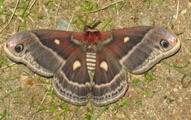Native Plants
Search for native plants by scientific name, common name or family. If you are not sure what you are looking for, try the Combination Search or our Recommended Species lists.
Larix laricina
Larix laricina (Du Roi) K. Koch
Tamarack, American Larch, Hacmatack, Black Larch
Pinaceae (Pine Family)
Synonym(s): Larix alaskensis, Larix laricina ssp. alaskensis, Larix laricina var. alaskensis
USDA Symbol: lala
USDA Native Status: L48 (N), AK (N), CAN (N), SPM (N)
American larch or tamarack is a slender-trunked, conical tree, 50-75 ft. tall, with bright green, deciduous needles. The glossy needles appear in remarkably soft tufts in early spring. Deciduous tree with straight, tapering trunk and thin, open, conical crown of horizontal branches; a shrub at timberline. In autumn they color golden-yellow before falling to the ground.
One of the northernmost trees, the hardy Tamarack is useful as an ornamental in very cold climates. Indians used the slender roots to sew together strips of birch bark for their canoes. Roots bent at right angles served the colonists as "knees" in small ships, joining the ribs to deck timbers. The durable lumber is used as framing for houses, railroad cross-ties, poles, and pulpwood. The larch sawfly defoliates stands in infrequent years, causing damage or death.
Plant Characteristics
Duration: PerennialHabit: Tree
Leaf Retention: Deciduous
Leaf Complexity: Simple
Breeding System: Flowers Unisexual , Monoecious
Fruit Type: Cone
Size Notes: Up to about 75 feet tall.
Leaf: Dark Green
Autumn Foliage: yes
Fruit: Brown
Bloom Information
Bloom Color: Red , Yellow , Green , BrownBloom Time: Apr
Distribution
USA: AK , CT , IL , IN , MA , MD , ME , MI , MN , NH , NJ , NY , OH , PA , RI , VT , WI , WVCanada: AB , BC , MB , NB , NL , NS , NT , ON , PE , QC , SK
Native Distribution: Boreal N. America, s. to B.C., c. MN, extreme n.e. IL, n. PA & NJ; also mts. of WV & MD
Native Habitat: Cold bogs & wet forests
Growing Conditions
Water Use: MediumLight Requirement: Sun , Shade
Soil Moisture: Moist , Wet
CaCO3 Tolerance: Low
Soil Description: Wet, acid soils.
Conditions Comments: Tamarack is one of the most cold-hardy native trees. It casts a light shade and may be underplanted with acid-loving wildflowers and shrubs. It is intolerant of shade, heat, and polluted areas. It is also intolerant of dry, shallow, chalky soils, but does adapt to sites slightly drier than its natural habitat. Its deciduousness makes it nearly immune to winter road salt. Prune, if necessary, in mid-summer. The tree is subject to Larch case-borer, Larch saw-fly, wood rot and several rust fungi. The Alaskan tamarack, var. alaskensis, is usually much smaller, barely reaching 30 ft. in height.
Benefit
Use Wildlife: Seeds are a favorite of crossbills, and the buds are eatem by spruce grouse. Tamaracks are often used as nesting sites.Use Other: Larch wood is not valued for lumber but has been used occasionally in rough construction and as poles, piers and railway ties. (Kershaw)
First Nations used the roots of tamarack for sewing the strips of birch bark in their canoes. (Peattie)
Attracts: Birds , Butterflies
Larval Host: Columbia silkmoth
Butterflies and Moths of North America (BAMONA)
|
Columbia silkmoth (Hyalophora columbia)  Larval Host |
Propagation
Description: Seeds germinate fairly well without pretreatment. Sow in fall. Any dormancy can be overcome with stratification. Cuttings are difficult to root. Loses needles in fall.Seed Collection: A ripe cone is made up of woody scales, each of which bears two seeds at the base. Seeds are wind dispersed, so many cones still on the tree may be empty. The seed is winged and triangular in shape. Collect in fall.
Seed Treatment: Pretreatment is not usually necessary. If seeded in spring, a cool-moist stratification for 20-60 days is often used.
Commercially Avail: yes
Find Seed or Plants
View propagation protocol from Native Plants Network.
National Wetland Indicator Status
| Region: | AGCP | AK | AW | CB | EMP | GP | HI | MW | NCNE | WMVE |
| Status: | FACW | FACW | FACW | FACW | FACW |
Bibliography
Bibref 1186 - Field Guide to Moths of Eastern North America (2005) Covell, C.V., Jr.Bibref 1185 - Field Guide to Western Butterflies (Peterson Field Guides) (1999) Opler, P.A. and A.B. Wright
Search More Titles in Bibliography
Additional resources
USDA: Find Larix laricina in USDA PlantsFNA: Find Larix laricina in the Flora of North America (if available)
Google: Search Google for Larix laricina
Metadata
Record Modified: 2019-08-19Research By: TWC Staff